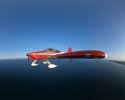Do you have stats on tri-gear vs tailwheel RV miscontrol mishaps? I could see that while the RV pilots have more time, many of them are probably moving to a tailwheel after years of flying trikes. Also, anything on recency of experience, and how long they’d had their RV?
I don't record the recency of experience. I do have the total time in the type of aircraft, but from what I can tell, the NTSB only records the last 90 days/last 30 days data regarding total time, not just in the accident aircraft.
Also have no convenient way to identify how long they'd owned the RV. I do estimate whether the airplane is owned by the builder vs. a purchaser based on the aircraft total time vs. time in type.
Breaking down RV statistics into taildragger vs. trigear has its problems. Vans' standard is that the trigear RVs are -A models. The NTSB does include the landing gear type as a separate entry. Out of my 101 entries for RV-6/RV-6A aircraft listed as having tricycle gear, 26 them are listed as RV-6 (e.g., no "A"). So if you do your own analysis, don't rely on the RV-6/RV-6A convention.
Anyway, out of 272 total entries, 168 are tricycle gear, 101 are taildraggers. The rest had blanks in the "landing gear" column; two were RV-6s, one was an RV-6A. In both cases, the percentage of aircraft that were owned by subsequent owners was about half. (Note that this determination is a rough one, based on the aircraft having more time than the pilot's time-in-type, with a bit of margin granted to reflect ground-testing time.)
Pilots of the tailwheel varieties had almost twice the number of hours as the tricycle-gear pilots. Median of 1,532 hours total time, vs. 800 hours.
Both types had roughly the same percentage of Pilot Miscontrol accidents... 47.5% for taildraggers, 48.2% for the trigears. However, the type of mistake showed some interesting variations...

(Note that the percentages don't add up to 100% as multiple events could occur during the same accident)
This seems to correlate with experience level. The taildragger pilots are more experience, hence they have fewer accidents involving stalling or bouncing. However, they DO show a greater occurrence of loss-of-directional-control accidents, both on landing and on taking off.
Keep in mind that percentages are deceptive in these types of analyses...one factor having a much higher percentage is naturally going to reduce percentages in other categories. So more occurrences of landing or takeoff directional control issues will result statistics that show fewer stalling cases.
Ron Wanttaja






